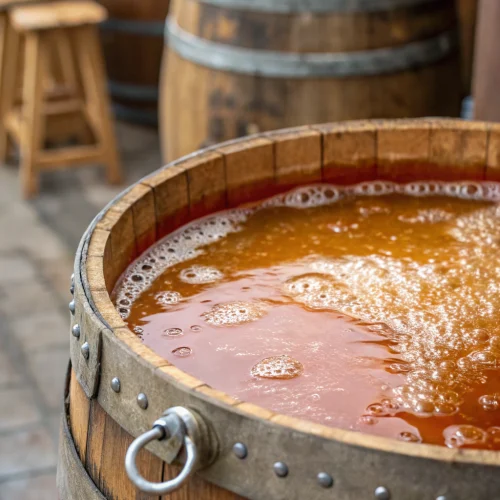
Traditional Hard Apple Cider
Connect with centuries of brewing tradition by creating your own authentic traditional hard apple cider at home. This simple fermentation process transforms fresh apple juice into a complex, slightly alcoholic beverage with no added sugars or preservatives.
Equipment
- Glass Carboy or Food-Grade Plastic Bucket
- Airlock and Bung
- Funnel
- Siphon
- Bottles for Storage
- Sanitizing Solution
Ingredients
Main Ingredients
- 1 gallon apple cider or juice unpasteurized and preservative-free
- 1 packet champagne yeast or cider yeast about 5 grams
- 1/4 tsp yeast nutrient optional but recommended
Optional Flavorings
- 2-3 tbsp honey or maple syrup for added sweetness
- 1 cinnamon stick for flavor
- 3-4 whole cloves for flavor
Instructions
- Thoroughly clean and sanitize your fermentation vessel (glass carboy or food-grade plastic bucket), airlock, bung, funnel, and any other equipment that will contact your cider. A solution of one tablespoon of unscented bleach per gallon of water works well—rinse thoroughly with clean water afterward.
- Check that your apple juice or cider is preservative-free. If pressing your own apples, consider using a mix of sweet, tart, and tannic varieties like Winesap, Granny Smith, Golden Delicious, and Honeycrisp for a balanced flavor profile.
- Rehydrate the yeast in warm water (about 104°F/40°C) for 15-20 minutes before adding it to the juice, following the instructions on your yeast packet.
- Pour the apple juice into your sanitized fermentation vessel, leaving about 2 inches of headspace at the top. Add the yeast nutrient if using, then the prepared yeast. Add optional spices or sweeteners if desired.
- Seal the vessel with the airlock and bung to allow carbon dioxide to escape while preventing outside air from entering.
- Place the vessel in a dark location with a consistent temperature between 65-75°F (18-24°C). Primary fermentation will continue for 7-14 days until the bubbling significantly slows or stops.
- After primary fermentation, carefully siphon the cider into a clean, sanitized carboy, leaving behind the sediment (lees) at the bottom. Allow the cider to age for another 2-4 weeks for improved clarity and flavor development.
- When fermentation is complete and the cider has cleared to your liking, transfer it to sanitized bottles. For still cider, simply seal bottles. For sparkling cider, add 1-2 teaspoons of sugar per bottle before sealing to create natural carbonation.
- Store bottles in a cool, dark place. The cider will continue to improve for 6-12 months, developing more complex flavors over time.
Notes
Traditional hard apple cider significantly improves with 1-3 months of aging. While technically drinkable after primary fermentation (1-2 weeks), patience yields a clearer, more flavorful final product.
Avoid using juice with preservatives like potassium sorbate or sodium benzoate, as these will prevent fermentation.
Bottling before fermentation is complete can create excessive pressure and potentially exploding bottles, so ensure fermentation has fully stopped.
For a lower alcohol content, dilute the finished cider with fresh apple juice before serving. For a drier cider with less sugar, allow fermentation to continue longer.
Nutrition
Calories: 135kcalCarbohydrates: 12gSodium: 10mgPotassium: 150mgSugar: 10gVitamin C: 2mg
Tried this recipe?Let us know how it was!